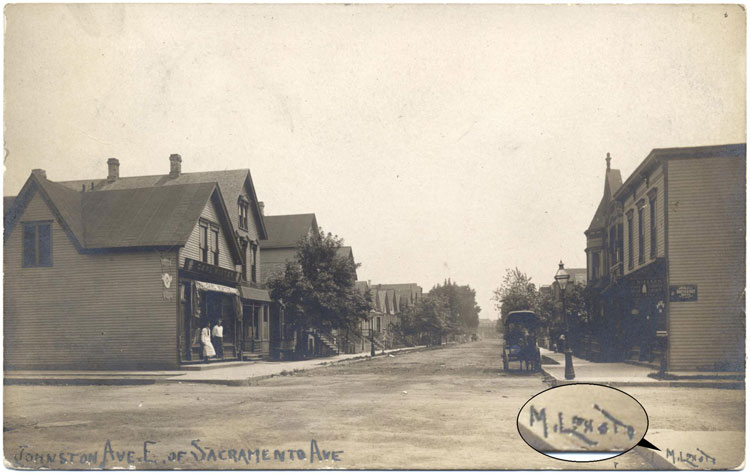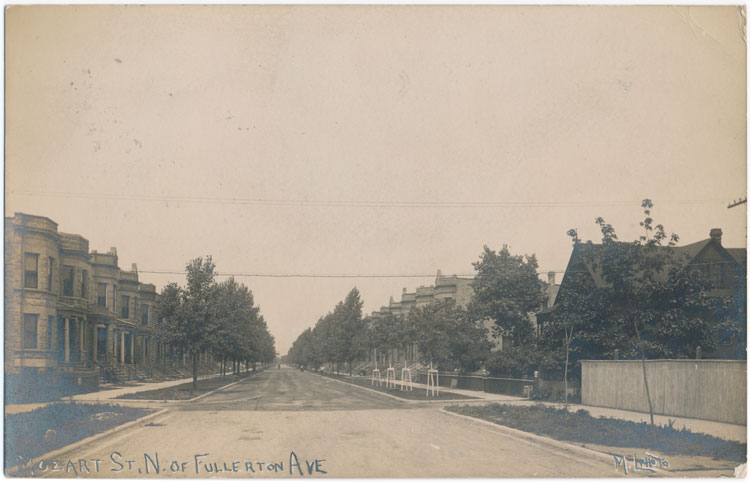
M-L Photo postcard view looking east down Lyndale from Sacramento Ave. ca. 1908. Postcard image courtesy Logan Square Preservation.
Street Photography
The postcard above provides a view of Lyndale Street (then called Johnston Ave.) from the opposite end of the same block pictured in another postcard view. The street is nearly empty in mid-morning aside from a parked carriage and two bored barkeeps at the Carl Winter saloon who are watching the photographer before preparing for the lunch crowd. Two doors down from the tavern, behind a tree, is the tiny house at 2950 which was lost in 2012.
Our good fortune in having multiple complementary views of the same street is due to the M-L Photo studio being located close by at 2837 N. Milwaukee, most likely in an office above the drug store there. Some time around 1907 the photographers Bismark "Ismar" Masure and Leon Leonhard formed a partnership and began producing photo postcards of street views from cities and small towns nearby in Illinois, Indiana and Michigan.
Souvenir picture postcards made their U.S. debut at Chicago's 1893 World's Columbian Exhibition, but it was not legal to write anything other than an address on the back of the card until a change of postal codes in March 1907. After that, postcards became a runaway hit, as quick and informal messages and as collectible views of places near and far.
Eastman Kodak produced a folding postcard-format camera in 1903 allowing anyone with a darkroom to print cards, but professional studios made "real photo" postcards as well. The photo prints could be made in large or small quantities without the high setup costs of traditional printing.

M-L Photo postcard view looking north on Mozart St. ca. 1908. Leonhard's house at 2426 is the sixth house from the left, hidden behind the first young tree. Postcard image courtesy Logan Square Preservation.
Leon Leonhard lived just a few blocks north of Lyndale at 2426 N. Mozart, where he roomed with the family of his friend Arthur English, who was also a photographer and perhaps worked for M-L Photo as well. Leonhard was a former barber and at age 40 the older partner in the business.
Ismar Masure was 28 in 1908 and probably learned the photography trade from his older brother Morris, who was a well-established portrait photographer with a studio near Maxwell Street at 14th and Halsted. Ismar and Morris lived with their parents at 912 W Belmont for several years before they all moved to the Woodlawn neighborhood, which must have made for a long commute if Ismar wanted to get to work at the Logan Square photo studio, but perhaps he spent most of his time out on the road shooting views of small towns and drumming up postcard sales.
In any case, M-L Photo prospered along with the postcard craze. By 1913 the company had seven employees, and Ismar claimed to be making $100 to $150 per week ($2500 to $3800 in today's dollars). In that year, Americans mailed more than 900 million postcards, but the public interest in the postcard fad faded in the next few years.
M-L Photo Studio presumably ceased business in 1915 when Ismar Masure moved to the small town of Whitehall, north of Muskegon, Michigan. There he ran a photo studio and greenhouse into the 1940s before passing away in 1952. Leon Leonhard continued working as a photographer on his own for a few years but by 1920 he had become an electrician, perhaps a more lucrative career for supporting his new wife and infant son. Leonhard passed away in 1938.
